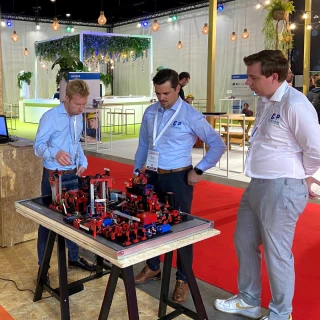End-to-end
integration via a digital twin
To see how these challenges would map onto specific Industry 4.0 solutions, Piet and Rens created a model that shows how various Industry 4.0 use cases create value together when they are combined and integrated end-to-end – from suppliers and operations to customers.
According to Rens, the glue that ties all these solutions together is a ‘digital twin’: “A digital twin is a virtual or digital replica of real-world, physical entities, e.g., devices, engines, machines, processes, or even entire businesses. It combines data from different sources, like your shop floor, ERP, CRM, MES, etc. In the end, it helps people make more educated, model-driven decisions.”
Roughly speaking, digital twins serve multiple purposes:
- Digital representation: what are the current parameters of a specific machine? What data can we gather from a device or an engine? And how does this data relate to other production lines or business areas within my company? Are there any connections we didn’t know about?
- Historical analysis: looking back on a specific timeframe to know what the exact conditions were at the time. By combining various data sources, a digital twin can help you understand why a breakdown occurred. These insights enable further optimization - e.g. in the form of predictive maintenance - which ultimately results in less downtime and improved performance.
- Simulations: determining the impact of specific changes to your production environment, based on historical data by simulating those changes. Find and understand potential points of failure and act upon those. Or think bigger: before building a new plant or releasing a new product, you could simulate them via their digital twin. In this way, you can check the feasibility and optimize where needed.
- Training: a digital twin of our shop floor or plant allows you to create a virtual environment (think ‘metaverse’) to simulate realistic training situations for your employees. These environments are risk-free, so your employees can learn or see dangerous procedures before doing them. Studies have shown that this immersive way of learning results in improved learning performance.

/Piet-Vanwolleghem-(1).webp?mode=autocrop&w=320&h=320&attachmenthistoryguid=3fe7a7cd-6816-4481-a37b-176007f28703&v=&focusX=239&focusY=271&c=d17099665f830f1e464fef25da839633e14cea3a81befb54f3f3f44e2769a7ed)
/MicrosoftTeams-image-(1).webp?mode=autocrop&w=320&h=320&attachmenthistoryguid=9d5a93c3-a0b3-414d-a57a-ad6497700c4a&v=&focusX=250&focusY=250&c=f2663c71c03ce1242e27ef72c895437b5d1839512022917bea80d0d76166ef03)


/thumbnail-(1).webp?mode=autocrop&w=320&h=240&attachmenthistoryguid=ec1e033b-7e89-42bb-9d48-20807958985a&v=&focusX=423&focusY=387&c=dcd2ff6e3f59b1765b1a2cb81bd5cd94b14f15ec004f71c4c19b892abb95403f)